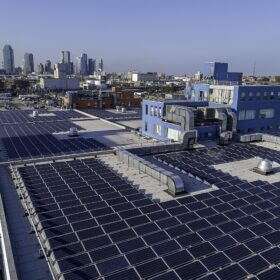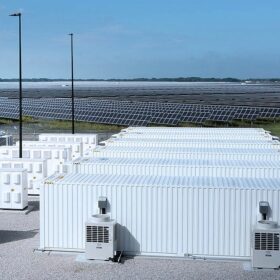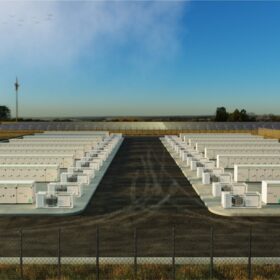President Donald Trump wasted no time imposing import tariffs, one of his key campaign promises. In his first few weeks in office, the president revamped much-eroded Section 232 tariffs on steel and aluminum, under the Trade Expansion Act of 1962. Trump also used 1977’s International Emergency Economic Powers Act (IEEPA) to impose a new 20% tariff on goods from China, plus 25% tariffs on Canada and Mexico, albeit after a delay in the latter cases.
Clean Energy Associates (CEA) does not expect the tariffs to have a significant impact on the solar or battery industries. Behind the levies, however, lurk more potent trade threats.
The Section 232 tariffs announced by Trump include “derivative” products, a definition that covers solar trackers, aluminum frames, and likely other items. Buying such products from domestic producers won’t necessarily shield solar and energy storage developers and engineering, procurement, and construction companies from cost impacts. As documented by news agency Reuters, and confirmed by CEA conversations with balance-of-system providers, domestic steel producers are raising prices in response to the tariffs.
IEEPA levies will increase prices for goods including electric transformers and switchgear, largely imported from Mexico. Over the mid-term, CEA expects the supply of transformers for the United States to shift to other low-cost locations. We expect neither the Section 232 nor IEEPA tariffs will, on their own, raise PV system or solar module bill of materials prices enough to have a significant impact on either U.S. manufacturing or deployment.
For battery energy storage systems (BESS), the market impact will likely be even less significant than for solar. Section 232 increases the costs of battery project enclosures, racks, and containers. Racks are the biggest concern among those three items. However, as racks only represent around 6% of the total cost of containerized BESS systems we expect the impacts to be relatively minor.
IEEPA tariffs will have even less effect than Section 232 levies on BESS prices, 20% tariffs on Chinese BESS are likely to simply be absorbed by the suppliers. The two tariffs combined will marginally disadvantage domestic cell makers and integrators but will have little impact on battery deployment.
Trump has pledged to impose additional tariffs on autos and semiconductor materials. While there has been no mention of solar or batteries, there is always the possibility that these will be included in subsequent proposals.
AD/CVD disruption
By far the larger danger to the solar and battery storage markets is not presidential tariffs, but the AD/CVD investigations currently underway at the U.S. Department of Commerce.
The imposition of provisional duties, under the AD/CVD case against Cambodia, Malaysia, Thailand, and Vietnam has already correlated with greatly reduced PV module import volumes – threatening to turn oversupply in the US market to undersupply. The duties have also resulted in a geographic shift in supply chains. Cell production is moving away from countries subject to duties in favor of Indonesia and Laos, and with promises of future factories in the Middle East also in the pipeline.
Meanwhile, the current AD/CVD investigation into anode active materials (AAMs) could significantly disrupt the U.S. battery market. Petitioners are seeking duties of 828% to 921%. While it is unlikely that companies who cooperate with the investigation will get duties that high, CEA’s analysis of AAM production inputs, and prices for Chinese AAM, suggests that the relevant data backs the argument for triple-digit duties.
Battery anodes and cells featuring Chinese AAM are included in the scope of this case, and any duties on batteries also apply to packs and containerized systems. Therefore, this means potentially high duties on battery cells, packs, and containerized systems.
It is important to remember that duties imposed under AD/CVD orders are not like other tariffs. AD/CVD duties are retroactively applied, impossible to predict in advance, and change annually. As such, they create unique challenges for suppliers, importers, and buyers, and create market disruption far greater than the numerical value of the duties may suggest.
UFLPA expands
One of the greatest threats to the U.S. solar and battery markets comes from neither tariffs nor duties. It is a law that specifically applies a legal prohibition on importing goods made with forced labor to products suspected of having inputs from the Chinese region of Xinjiang.
Under the UFLPA, $3 billion worth of “electronics” have been detained since June 2022. Based on CEA’s conversations with suppliers and buyers, we believe that PV modules represent the vast majority of those detentions.
In January 2025, the Forced Labor Enforcement Task Force (FLETF), which oversees UFLPA strategy, added five Chinese companies involved in ingot and wafer production to the UFLPA entity list. That is the list of companies whose products cannot be imported, wholly or in part, to the United States.
Previously, only polysilicon and metallurgical grade silicon makers based in Xinjiang had been added to the entity list, based on allegations of on-site forced labor. In the ingot and wafer makers’ case, their addition to the entity list made no allegations of forced labor in their facilities. Instead, their inclusion on the list stemmed from their procurement of polysilicon potentially associated with forced labor.
It is not hard to see how that move downstream could be expanded upon during the Trump administration. The risk of more clean energy equipment detention, and entity list additions is particularly acute when considering past statements made by Secretary of State Marco Rubio who, in his new role, has a seat on the FLETF.
As a senator, Rubio repeatedly joined other members of Congress in urging FLETF to expand the entity list and take other actions to further restrict imports that could have Xinjiang content.
“It is our contention that UFLPA implementation requires a robust entity list that can be a useful guide for importers and CBP [U.S. Customs and Border Protection] operations,” read one statement signed by Rubio and three other members of Congress in April 2023. “Numerous civil society groups have compiled data on many entities that are linked to the XUAR [Xinjiang Uyghur autonomous region] and forced labor that are not currently included in the Forced Labor Enforcement Task Force (FLETF) list.”
In June 2024, Rubio and four other members of Congress sent a letter to FLETF calling for major Chinese battery makers CATL and Gotion to be added to the entity list.
Compound risk
The existing and potential impact from U.S. tariffs and duties, and the threat of UFPLA action, constitute substantial risk for buyers, importers, and suppliers in the solar and battery industries. That is without even considering the risk that the investment and production tax credits those industries enjoy could face an early sunset, new requirements, or repeal.
Furthermore, the uncertainty around tariff levels and the rapid pace of policy change makes for a challenging environment for clean energy investment, particularly for capital-intensive projects such as factories, that will take years to pay off. Tracking policy changes at a granular level is essential for any company considering making investment in the near term.
Eventually, the risks faced by the solar and BESS industries will play out and the clean energy industry will find a new equilibrium. The timelines of various processes, including for budget reconciliation, mean it could take months or even more than a year before policy changes are finalized. In the interim, every industry participant should seek out trusted sources of information and analysis and follow them diligently.
 About the author: Christian Roselund leads policy research and communication on CEA’s market intelligence team with a focus on trade, supply chains, and national policy. He has 15 years of experience in clean energy, including serving as a founding editor of pv magazine USA and as editorial director at nonprofit the Rocky Mountain Institute. He has written extensively about solar policy, manufacturing, and technology.
About the author: Christian Roselund leads policy research and communication on CEA’s market intelligence team with a focus on trade, supply chains, and national policy. He has 15 years of experience in clean energy, including serving as a founding editor of pv magazine USA and as editorial director at nonprofit the Rocky Mountain Institute. He has written extensively about solar policy, manufacturing, and technology.
This content is protected by copyright and may not be reused. If you want to cooperate with us and would like to reuse some of our content, please contact: editors@pv-magazine.com.









By submitting this form you agree to pv magazine using your data for the purposes of publishing your comment.
Your personal data will only be disclosed or otherwise transmitted to third parties for the purposes of spam filtering or if this is necessary for technical maintenance of the website. Any other transfer to third parties will not take place unless this is justified on the basis of applicable data protection regulations or if pv magazine is legally obliged to do so.
You may revoke this consent at any time with effect for the future, in which case your personal data will be deleted immediately. Otherwise, your data will be deleted if pv magazine has processed your request or the purpose of data storage is fulfilled.
Further information on data privacy can be found in our Data Protection Policy.